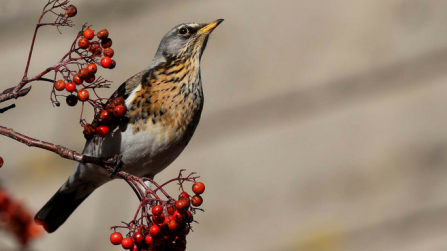
Fieldfare by Margaret Holland

Fieldfare by Margaret Holland
Our winter visitors are starting to arrive, and among them is the fieldfare – a large, colourful member of the thrush family. It has a chestnut-brown back and yellowy breast, streaked with black, and a black tail, dark wings and pale grey rump and head.
They arrive in the UK in the autumn, in time to take advantage of the feast of berries on offer, and will arrive later in years when the berry crop in Scandinavia has been particularly good.
They are sociable birds, so look out for them in large flocks in fields and in hedgerows. Hawthorn hedges laden with berries are one of their favourites.
Do you have trouble telling the difference between fieldfares and redwings?

Water vole by Terry Whittaker/2020VISION
Late summer is a good time to look out for water voles as the vegetation along river banks is starting to die back. There are also lots of young water voles around as they’ve grown large enough to leave the burrows and find food for themselves.
Did you know BBOWT’s water vole recovery project is the longest-running such project in the UK?

Goldfinch by Bob Coyle
September provides a feast of seed heads for goldfinches, including groundsel, ragwort, dandelions and more.
Their long, fine beaks give them exclusive access to the seeds of teasels and thistles It’s a treat if you can spot them clinging to the stem and tearing into the seed head – one of many reasons to plant some in your garden!
But only male goldfinches are able to exploit the teasel heads, as female goldfinches have shorter beaks and have to make do with other species.

Giant house spider by Dr Malcom Storey/ false widow spider by Badgreeb Pictures
Like it or not, this is spider mating season, which is why we start to see so many of them in our houses. Most of the spiders you’ll see will be male house spiders, following the scent trails of breeding females. They tend to follow the same route each night, and tire easily. So if you notice a spider stop in its tracks, it’s not because it’s noticed you – it’s catching its breath!
You can also expect to see money, cellar, false widow and lace web spiders over the next few weeks. But don’t worry if you’re not a fan, none of these are dangerous to humans and they’ll be seen less in a few weeks.

Great crested newt
Of the seven species of amphibian native to the UK, three are newts. Undoubtedly the most famous of these is the great crested newt, which is our largest newt, almost black in colour with warty skin and a striking orange belly.
Metamorphosis of this year’s brood from tadpole to newt is completed by the end of this month, when the young adults are ready to leave the water for winter hibernation. They hibernate underground, among tree roots and in old walls, coming out in milder weather to feed. Newts are nocturnal, so the best time to see them on the move is on a dark, wet night!
Why not make a pond in your garden to support amphibians?

As dusk gets earlier why not head out and look for badgers feeding on fruit and nuts, and digging for worms and insect larvae. Head to a sett before sunset and sit quietly – you may be lucky to see them emerge and feed!

Hobbies are amazing aerial acrobats, catching, and often even eating, prey such as dragonflies while flying. They will even catch small birds to eat. They spend the summer in Britain before heading back to warmer, southern countries for the winter.
Look out for them flying over heathland, wetlands and along woodland edges where there is plenty of food for them to catch.

A jay doing its duty for the next generation of oak trees. Photo by Margaret Holland
Although they are here all year, jays spend most of the year hidden away in woodland so you might not spot them. But in the autumn you can see them gathering and storing acorns to eat during the winter – they will cache up to 3,000 a month. Look out for them burying acorns on lawns. Listen out too, they make a loud screeching call, which is generally heard more often than jays are seen.
Did you know their scientific name, Garrulus glandarius, translates roughly as ‘chattering acorn gatherer’.

You can still see butterflies flying around on warm days in late summer and early autumn, especially species that have two or three broods a year, like the speckled wood. Look out for them flying in sunny glades and along rides in woodland, or basking in pools of sunshine.
Clouded yellows are a migratory butterfly, arriving in Britain from North Africa and southern Europe. Most years they turn up in small numbers, but occasionally there will be a mass migration. Keep an eye out for them as you may see them in many different habitats, particularly chalk grassland.
Puffballs by Les Binns
Don’t wait until the midst of autumn to look for fungi. Giant puffballs can already be found – they love nutrient-rich soil, so look out for them next to stinging nettles.
When young they are pure white, but as they mature they turn brown and eventually crack open to release their spores.

Did you know every month we produce wildlife wallpaper for you to use on your computer, tablet or mobile phone?